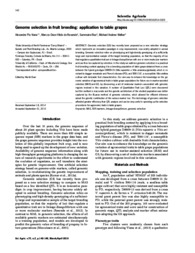Genome selection in fruit breeding: application to table grapes.
Genome selection in fruit breeding: application to table grapes.
Author(s): VIANA, A. P.; RESENDE, M. D. V. de; RIAZ, S.; WALKER, M. A.
Summary: Genomic selection (GS) has recently been proposed as a new selection strategy which represents an innovative paradigm in crop improvement, now widely adopted in animal breeding. Genomic selection relies on phenotyping and high-density genotyping of a sufficiently large and representative sample of the target breeding population, so that the majority of loci that regulate a quantitative trait are in linkage disequilibrium with one or more molecular markers and can thus be captured by selection. In this study we address genomic selection in a practical fruit breeding context applying it to a breeding population of table grape obtained from a cross between the hybrid genotype D8909-15 (Vitis rupestris × Vitis arizonica/girdiana), which is resistant to dagger nematode and Pierce?s disease (PD), and ?B90-116?, a susceptible Vitis vinifera cultivar with desirable fruit characteristics. Our aim was to enhance the knowledge on the genomic variation of agronomical traits in table grape populations for future use in marker-assisted selection (MAS) and GS, by discovering a set of molecular markers associated with genomic regions involved in this variation. A number of Quantitative Trait Loci (QTL) were discovered but this method is inaccurate and the genetic architecture of the studied population was better captured by the BLasso method of genomic selection, which allowed for efficient inference about the genetic contribution of the various marker loci. The technology of genomic selection afforded greater efficiency than QTL analysis and can be very useful in speeding up the selection procedures for agronomic traits in table grapes.
Publication year: 2016
Types of publication: Journal article
Unit: Embrapa Forestry
Observation
Some of Embrapa's publications are published as ePub files. To read them, use or download one of the following free software options to your computer or mobile device. Android: Google Play Books; IOS: iBooks; Windows and Linux: Calibre.
Access other publications
Access the Agricultural Research Database (BDPA) to consult Embrapa's full library collection and records.
Visit Embrapa Bookstore to purchase books and other publications sold by Embrapa.

